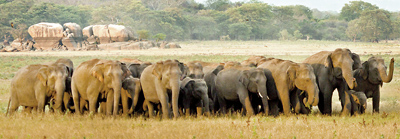News
The tuskers of Kalawewa now have a sanctuary
Adding another national park to Sri Lanka’s protected areas, the government declared the wilderness around Kalawewa and Balaluwewa a sanctuary.

Kalawewa is particularly famous for tuskers © Rajiv Welikala
Wildlife and Sustainable Development Minister Gamini Jayawickrema Perera declared open the national park yesterday. Environmentalists welcome the move saying the protection was long overdue.
The Kalawewa reservoir was built by King Dhatusena who ruled the country in the fifth century. He also built the Balaluwewa and linked them to make a very large tank to be used for ancient agriculture.
These tanks were renovated and now hold water all year around, attracting wildlife.
In the case of elephants, as happens at the Minneriya and Kaudulla tanks where the “Gathering” of elephants takes place as the water levels drop in the dry season, the tank bed becomes lush grassland, providing the animals with fodder.
As the Kalawewa-Balaluwewa complex is fairly shallow, the effect is more noticeable.
GPS radio-tracking of a female and male elephant by the Department of Wildlife Conservation and the Centre for Conservation and Research has shown that some of the herds remain in the vicinity throughout the year.
Elephant herds on the banks of the Kalawewa are particularly famous for the high number of tuskers. Many wildlife enthusiasts visit the area regularly.
Rajiv Welikala, a nature enthusiast and wildlife photographer who visits the area annually, says it is one of the most beautiful places in Sri Lanka.
“There could be 150-200 elephants at Kalawewa with dozens of tuskers, both young and mature.
“The birdlife in the tank is also fascinating, with a very large openbill stork flock that consists of thousands of birds. When they take wing the sound can be heard from a distance,” he said.
Sadly, the number of elephants at Kalawewa appears to be decreasing. Conservationists fear the electric fences constructed to minimise human-elephant conflict are preventing seasonal movement of the elephant herds, blocking their use of other areas.
In recent months, three other national parks in the northern region were declared: Delft Island, Chundikulam and the Adam’s Bridge sand islands. The Kalawewa National Park became the country’s 26th national park.
Although we have a considerable number of parks, most of them are experiencing problems from poaching, over-visiting, invasive species, herding of cattle etc.
In the case of Kalawewa, it is critical to ascertain the ranging patterns and habitat use of the elephants and design barriers based on that information.
If the entire park is surrounded by boundary electric fences, that will spell the end for the elephants, for whose benefit it was created.

